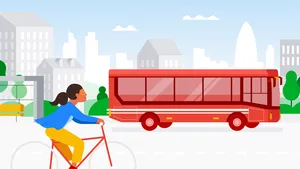Our 2023 Environmental Report

Today we shared our 2023 Environmental Report outlining how we are empowering individuals to take action, working together with our partners and customers, and operating our business sustainably.
For the sixth year in a row, we've matched 100% of our annual global electricity use with renewable energy purchases, even as our business has grown. We are now working to address the issue that renewable energy is not available all the time and everywhere by aiming to run on carbon-free energy (CFE) 24/7 and to achieve net-zero emissions across all of our operations and value chain by 2030. As we continue to help build a more sustainable future, we’re also focusing on two emerging opportunities: the use of artificial intelligence (AI) and empowering others with information to reduce emissions. By making information accessible and driving innovation forward through our products and platforms that billions of people engage with every day, we can help drive positive action for people and our planet.
Here’s a look at the key progress we made in 2022:
- AI for sustainability: We’re applying AI to problems that can help people live more sustainably and adapt to climate change. For example, in 2022, we launched Flood Hub, which allows local governments and aid organizations to identify when a riverine flood will occur up to seven days in advance. AI is a powerful tool for optimization and we are using it to optimize our own operations, and we’re working to reduce energy use and emissions from AI computing in our data centers.
- Helpful information: Last year, our core products helped over 1 billion users make more sustainable choices. For example, as of the end of 2022, eco-friendly routing in Maps provided users with information that is estimated to have helped prevent more than 1.2 million metric tons of carbon emissions since launch — equivalent to taking approximately 250,000 fuel-based cars off the road for a year. 1
- Clean energy: To help make progress toward our goal to achieve net-zero emissions, we achieved approximately 64% round-the-clock CFE across all of our data centers and offices. This past year, we expanded our CFE reporting to include offices and third-party data centers, in addition to Google-owned and operated data centers. We signed up for more clean energy this year than ever before with 20 renewable energy agreements in 2022 and an estimated future spend of more than $4 billion. 2
- Sustainable campuses: We opened our new Bay View campus, which is all-electric and net water-positive. The campus also restores over 17 acres of high-value nature and incorporates the leading principles of circular design.
- Water replenishment: At the end of 2022, our contracted watershed projects have replenished 271 million gallons of water — equivalent to more than 400 Olympic-sized swimming pools — to support our target to replenish 120% of the freshwater we used.
This transition to a more sustainable future is going to be very challenging — both for us and for the world at large — and there’s no playbook for making it happen. But we see our efforts as part of a bigger picture, setting our goals to help scale global solutions, and we're optimistic that we can, through our efforts in both information and innovation, play a helpful role in accelerating climate action.








